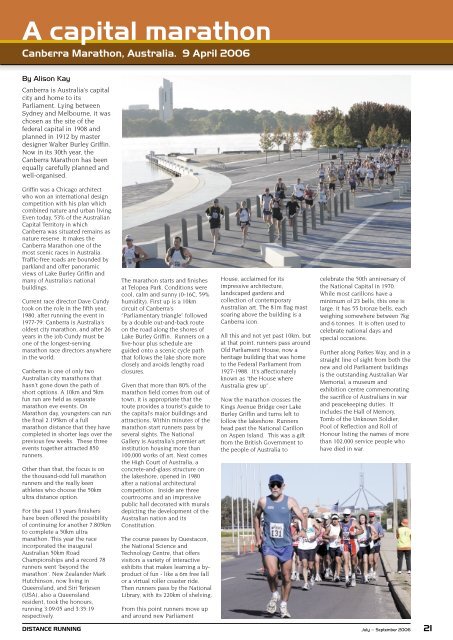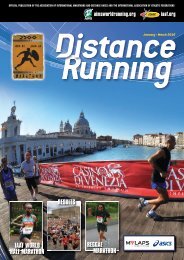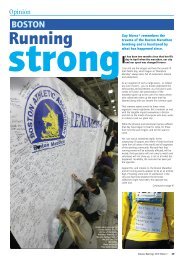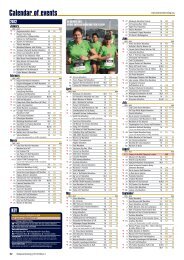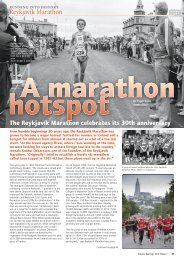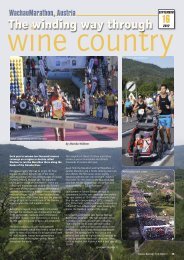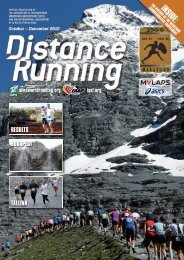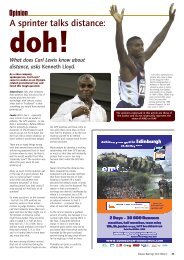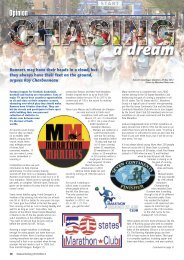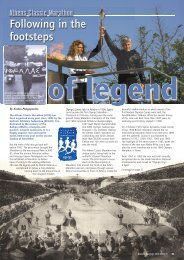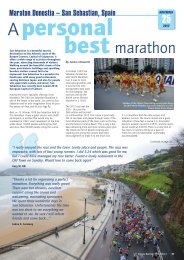Download pdf - Distance Running magazine
Download pdf - Distance Running magazine
Download pdf - Distance Running magazine
Create successful ePaper yourself
Turn your PDF publications into a flip-book with our unique Google optimized e-Paper software.
A capital marathon<br />
Canberra Marathon, Australia. 9 April 2006<br />
By Alison Kay<br />
Canberra is Australia’s capital<br />
city and home to its<br />
Parliament. Lying between<br />
Sydney and Melbourne, it was<br />
chosen as the site of the<br />
federal capital in 1908 and<br />
planned in 1912 by master<br />
designer Walter Burley Griffin.<br />
Now in its 30th year, the<br />
Canberra Marathon has been<br />
equally carefully planned and<br />
well-organised.<br />
Griffin was a Chicago architect<br />
who won an international design<br />
competition with his plan which<br />
combined nature and urban living.<br />
Even today, 53% of the Australian<br />
Capital Territory in which<br />
Canberra was situated remains as<br />
nature reserve. It makes the<br />
Canberra Marathon one of the<br />
most scenic races in Australia.<br />
Traffic-free roads are bounded by<br />
parkland and offer panoramic<br />
views of Lake Burley Griffin and<br />
many of Australia’s national<br />
buildings.<br />
Current race director Dave Cundy<br />
took on the role in the fifth year,<br />
1980, after running the event in<br />
1977-79. Canberra is Australia’s<br />
oldest city marathon, and after 26<br />
years in the job Cundy must be<br />
one of the longest-serving<br />
marathon race directors anywhere<br />
in the world.<br />
Canberra is one of only two<br />
Australian city marathons that<br />
hasn’t gone down the path of<br />
short options. A 10km and 5km<br />
fun run are held as separate<br />
marathon eve events. On<br />
Marathon day, youngsters can run<br />
the final 2.195km of a full<br />
marathon distance that they have<br />
completed in shorter legs over the<br />
previous few weeks. These three<br />
events together attracted 850<br />
runners.<br />
Other than that, the focus is on<br />
the thousand-odd full marathon<br />
runners and the really keen<br />
athletes who choose the 50km<br />
ultra distance option.<br />
For the past 13 years finishers<br />
have been offered the possibility<br />
of continuing for another 7.805km<br />
to complete a 50km ultra<br />
marathon. This year the race<br />
incorporated the inaugural<br />
Australian 50km Road<br />
Championships and a record 78<br />
runners went ‘beyond the<br />
marathon’. New Zealander Mark<br />
Hutchinson, now living in<br />
Queensland, and Siri Terjesen<br />
(USA), also a Queensland<br />
resident, took the honours,<br />
running 3:09:05 and 3:35:19<br />
respectively.<br />
The marathon starts and finishes<br />
at Telopea Park. Conditions were<br />
cool, calm and sunny (0-16C, 59%<br />
humidity). First up is a 10km<br />
circuit of Canberra’s<br />
“Parliamentary triangle” followed<br />
by a double out-and-back route<br />
on the road along the shores of<br />
Lake Burley Griffin. Runners on a<br />
five-hour plus schedule are<br />
guided onto a scenic cycle path<br />
that follows the lake shore more<br />
closely and avoids lengthy road<br />
closures.<br />
Given that more than 80% of the<br />
marathon field comes from out of<br />
town, it is appropriate that the<br />
route provides a tourist’s guide to<br />
the capital’s major buildings and<br />
attractions. Within minutes of the<br />
marathon start runners pass by<br />
several sights. The National<br />
Gallery is Australia’s premier art<br />
institution housing more than<br />
100,000 works of art. Next comes<br />
the High Court of Australia, a<br />
concrete-and-glass structure on<br />
the lakeshore, opened in 1980<br />
after a national architectural<br />
competition. Inside are three<br />
courtrooms and an impressive<br />
public hall decorated with murals<br />
depicting the development of the<br />
Australian nation and its<br />
Constitution.<br />
The course passes by Questacon,<br />
the National Science and<br />
Technology Centre, that offers<br />
visitors a variety of interactive<br />
exhibits that makes learning a byproduct<br />
of fun - like a 6m free fall<br />
or a virtual roller coaster ride.<br />
Then runners pass by the National<br />
Library, with its 220km of shelving.<br />
From this point runners move up<br />
and around new Parliament<br />
House, acclaimed for its<br />
impressive architecture,<br />
landscaped gardens and<br />
collection of contemporary<br />
Australian art. The 81m flag mast<br />
soaring above the building is a<br />
Canberra icon.<br />
All this and not yet past 10km, but<br />
at that point, runners pass around<br />
Old Parliament House, now a<br />
heritage building that was home<br />
to the Federal Parliament from<br />
1927-1988. It’s affectionately<br />
known as “the House where<br />
Australia grew up”.<br />
Now the marathon crosses the<br />
Kings Avenue Bridge over Lake<br />
Burley Griffin and turns left to<br />
follow the lakeshore. Runners<br />
head past the National Carillon<br />
on Aspen Island. This was a gift<br />
from the British Government to<br />
the people of Australia to<br />
celebrate the 50th anniversary of<br />
the National Capital in 1970.<br />
While most carillons have a<br />
minimum of 23 bells, this one is<br />
large. It has 55 bronze bells, each<br />
weighing somewhere between 7kg<br />
and 6 tonnes. It is often used to<br />
celebrate national days and<br />
special occasions.<br />
Further along Parkes Way, and in a<br />
straight line of sight from both the<br />
new and old Parliament buildings<br />
is the outstanding Australian War<br />
Memorial, a museum and<br />
exhibition centre commemorating<br />
the sacrifice of Australians in war<br />
and peacekeeping duties. It<br />
includes the Hall of Memory,<br />
Tomb of the Unknown Soldier,<br />
Pool of Reflection and Roll of<br />
Honour listing the names of more<br />
than 102,000 service people who<br />
have died in war.<br />
DISTANCE RUNNING July – September 2006<br />
21


